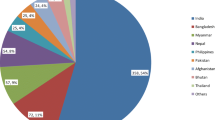Abstract
Background
This study aimed to investigate the key factors in medical disputes (arguments) among female patients after cosmetic surgery in Taiwan and to explore the correlates of medical litigation.
Methods
A total of 6,888 patients (3,210 patients from two hospitals and 3,678 patients from two clinics) received cosmetic surgery from January 2001 to December 2009. The inclusion criteria specified female patients with a medical dispute. Chi-square testing and multiple logistic regression analysis were used to analyze the data.
Results
Of the 43 patients who had a medical dispute (hospitals, 0.53%; clinics, 0.73%), 9 plaintiffs eventually filed suit against their plastic surgeons. Such an outcome exhibited a decreasing annual trend. The hospitals and clinics did not differ significantly in terms of patient profiles. The Chi-square test showed that most patients with a medical dispute (p < 0.05) were older than 30 years, were divorced or married, had received operations under general anesthesia, had no economic stress, had a history of medical litigation, and eventually did not sue the surgeons. The test results also showed that the surgeon’s seniority and experience significantly influenced the possibility of medical dispute and nonlitigation. Multiple logistical regression analysis further showed that the patients who did decide to enter into litigation had two main related factors: marital stress (odds ratio [OR], 10.67; 95% confidence interval [CI], 1.20–94.73) and an education level below junior college (OR, 9.33; 95% CI, 1.01–86.36).
Conclusion
The study findings suggest that the key characteristics of patients and surgeons should be taken into consideration not only in the search for ways to enhance pre- and postoperative communication but also as useful information for expert testimony in the inquisitorial law system.




Similar content being viewed by others
References
Wu CY, Lai HJ, Chen RC (2009) Status of medicolegal problems in Taiwan. Formosan J Med 13:1–8
Wu CY, Lai HJ, Chen RC (2009) Patient characteristics predict occurrence and outcome of complaints against physicians: a study from a medical center in central Taiwan. J Formos Med Assoc 108:126–134
Sloan FA, Bovbjerg RR, Githens PB (1991) Insuring medical malpractice. Oxford University Press, New York, NY
Bal BS (2009) An introduction to medical malpractice. Clin Orthop Relat Res 467:339–347
Feldman EA (2009) Why patients sue doctors: the Japanese experience. J Law Med Ethics 37:792–799
Hill HF, Read S (2005) Dermatology’s malpractice experience: clinical settings for risk management. J Am Acad Dermatol 53:134–137
Coleman WP, Hanke CW, Lillis PL (1999) Does the location of the surgery or the specialty of physician affect malpractice claims in liposuction? Am Soc Dermatol Surg 25:343–347
Hartz A, Green MD, Yoho R (2006) A new tool for assessing standard of care in medical malpractice cases. Plast Reconstr Surg 117:1632–1637
Clarke JR (2006) How a system for reporting medical errors can and cannot improve patient safety. Am Surg 72:1088–1091
Kessler DP, Summerton N, Graham JR (2006) Effects of the medical liability system in Australia, the UK, and the USA. Lancet 368:240–246
Bhattacharyya T, Yeon H, Harris MB (2005) The medical-legal aspects of informed consent in orthopaedic surgery. J Bone Joint Surg Am 87:2395–2400
Tucker WA, McKay BJ (2005) The negative impact of litigation on women’s health care. Gend Med 2:189–196
Powis SJM (1999) Origin and history of hebrew law. Jones & Barlett, Boston, MA
Di Rocco C (2010) Malpractice and medical litigation. Childs Nerv Syst 26:1655–1657
Studdert DM, Mello MM, Gawande AA, Gandhi TK, Kachalia A, Yoon C, Puopolo AL, Brennan TA (2006) Claims, errors, and compensation payments in medical malpractice litigation. N Engl J Med 354:2024–2033
Brennan TA, Leape LL, Laird NM (1991) Incidence of adverse events and negligence in hospitalized patients: results of Harvard medical practice study I. N Engl J Med 324:370–376
Yang CM, Chiu WT (2006) The risk of malpractice litigation in care to head injury patients in comparison with other high-risk patient groups: an inpatient-based epidemiological study in Taiwan. Surg Neurol 66(S2):43–47
Dalton GD, Samaropoulos XF, Dalton AC (2008) Improvement in the safety of patient care can help end the medical malpractice crisis in the United States. Health Policy 86:153–162
Maeda S, Sakamoto N, Nobutomo K (2001) The problems of medical malpractice litigation in Japan: the significant factors responsible for the tendency of patients to avoid litigation. Legal Med 3:56–62
Hagihara A, Nishi M, Nobutomo K (2003) Standard of care and liability in medical malpractice litigation in Japan. Health Policy 65:119–127
Robinson GO (1986) The medical malpractice crisis of the 1970s: a retrospective. Law Contemp Probs 49:5–35
Floyd TK (2006) Medical malpractice: trends in litigation. Gastroenterology 134:1822-25e
Saprr LF, Atkinson RM (1986) Postraumatic stress disorder as an insanity defense: medicolegal quicksand. Am J Psychiatry 143:608–612
Leape LL, Berwick DM (2005) Five years after to err is human: what have we learned? JAMA 293:2384–2390
Kent G (1996) Shared understandings for informed consent: the relevance of psychological research on the provision of information. Soc Sci Med 43:1517–1523
Jensen GA, Spurr SJ, Weycker DA (1999) Physicians and the risk of medical malpractice: the role of prior litigation in predicting the future. Qual Rev Econ Finance 39:267–289
Rohrich RJ, McGrath MH, Lawrence TW (2008) Plastic surgeons over 50: practice patterns, satisfaction, and retirement plans. Plast Reconstr Surg 121:1458–1474
Stelfox HT, Gandhi TK, Orav EJ (2005) The relation of patient satisfaction with complaints against physicians and malpractice lawsuits. Am J Med 118:1126–1133
Erzurum VZ, Obermeyer RJ, Fecher A (2000) What influences medical students’ choice of surgical careers. Surgery 128:253–256
Author information
Authors and Affiliations
Corresponding author
Rights and permissions
About this article
Cite this article
Lyu, SY., Liao, CK., Chang, KP. et al. Analysis of Medical Litigation Among Patients with Medical Disputes in Cosmetic Surgery in Taiwan. Aesth Plast Surg 35, 764–772 (2011). https://doi.org/10.1007/s00266-011-9684-1
Received:
Accepted:
Published:
Issue Date:
DOI: https://doi.org/10.1007/s00266-011-9684-1




